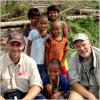Case Studies
From Doctor's Office to Disaster Area, LifeProof Safeguards Tech Tools
“To keep his mobile technology safe from water, drops, dirt and body fluid, Diamond counts the LifeProof frē as part of his standard equipment.”
A far cry from the typical sterile hospital or clinic environment, medical response in a post-disaster area brings with it a slew of new and unique challenges for emergency responders. Performance under pressure is what Dr. Dan Diamond thrives on. The Washington-based medical director has led medical teams following several natural disasters and has found that mobile technology helps overcome some of the obstacles unique to a disaster area. To keep his mobile technology safe from water, drops, dirt and body fluid, Diamond counts the LifeProof frē as part of his standard equipment.
Diamond’s passion for medical care was apparent at a young age, and he knew he’d become a doctor by the sixth grade. He practiced family medicine for 24 years before transitioning to urgent care medicine. Diamond currently serves as Medical Director for Harrison Urgent Care Clinics in Port Orchard, Wash. His international service career started early as well with a rotation in Thailand, working in a refugee camp with United Nations High Commission for Refugees and World Concern as a fourth year medical student.
“Once you get something like that in your blood, it is hard to think about not doing it again,” he said. “After that experience, when I completed my residency, I started looking for opportunities to do international disaster medicine and have worked with a variety of different organizations.”
Hurricane Katrina
Over the course of 30 years, he’s been a part of more than a dozen response teams. Lately, he’s been dedicated to working with Medical Teams International. Diamond’s led several disaster response teams for the group, including those responding to Hurricane Katrina in New Orleans and Typhoon Haiyan in the Philippines.
The response to Hurricane Katrina was a game-changer for Diamond in many ways. Before arriving, he anticipated he would come in contact with many victims, but what he found was that there were many impacted that refused to consider themselves victims as well. He was so moved by the experiences there that he started blogging from the field using mobile technology. Over the course of a few days, thousands of people were reading his updates.
An early-adopter of technology, Diamond has found his Apple iPhone to be an invaluable tool. He was the second physician in the state of Washington to write a prescription using handheld technology, pointing out that he was second by only 30 minutes. In the field, mobile technology has proven to provide more than just convenience and efficiency.
“LifeProof has given me that freedom to be able to use my phone differently than I could before.”
“Having mobile technology in the middle of a disaster changes everything. There is no way I could pack a bunch of books and take them with me into disasters. We don’t have the space or the weight available to us,” he said. “When I am deployed, it goes beyond just my peace of mind, it goes to ‘am I going to be able to meet the needs of the people who I am taking care of? Will I be able to communicate with the people I need to communicate with so that I can get the supplies that I need?’ It really gets to the point where people’s lives depend on the technology that I am using, and if it’s not functioning, the outcome could be horrible.”
Diamond uses the LifeProof frē all-protective case to keep his iPhone safe from water, drops, dirt, body fluids and just about anything else thrown his way during a disaster deployment. His phone becomes a medication reference guide, GPS, means of communication and a way to document the deployment.
“Having a LifeProof case changes the utility of having an iPhone for me. Otherwise, the iPhone would be something I would feel like I would need to guard and protect,” he said. “Once it is in my LifeProof case I don’t think about my iPhone being a fragile piece of technology. I think of this as a tool I can use to go do the work that I need to do. LifeProof has given me that freedom to be able to use my phone differently than I could before.”
About LifeProof
Based in San Diego, LifeProof designs, manufactures and markets cases for smartphones and tablets that deliver protection, style and functionality. LifeProof is built on the idea of giving everyone the complete freedom and confidence to use their mobile devices in any environment. Designed to defend against water, dirt, snow, shock and the hazards of daily life, LifeProof lets consumers use their mobile device everyday, everywhere, for everything — without worry. For more information, visit www.lifeproof.com.


